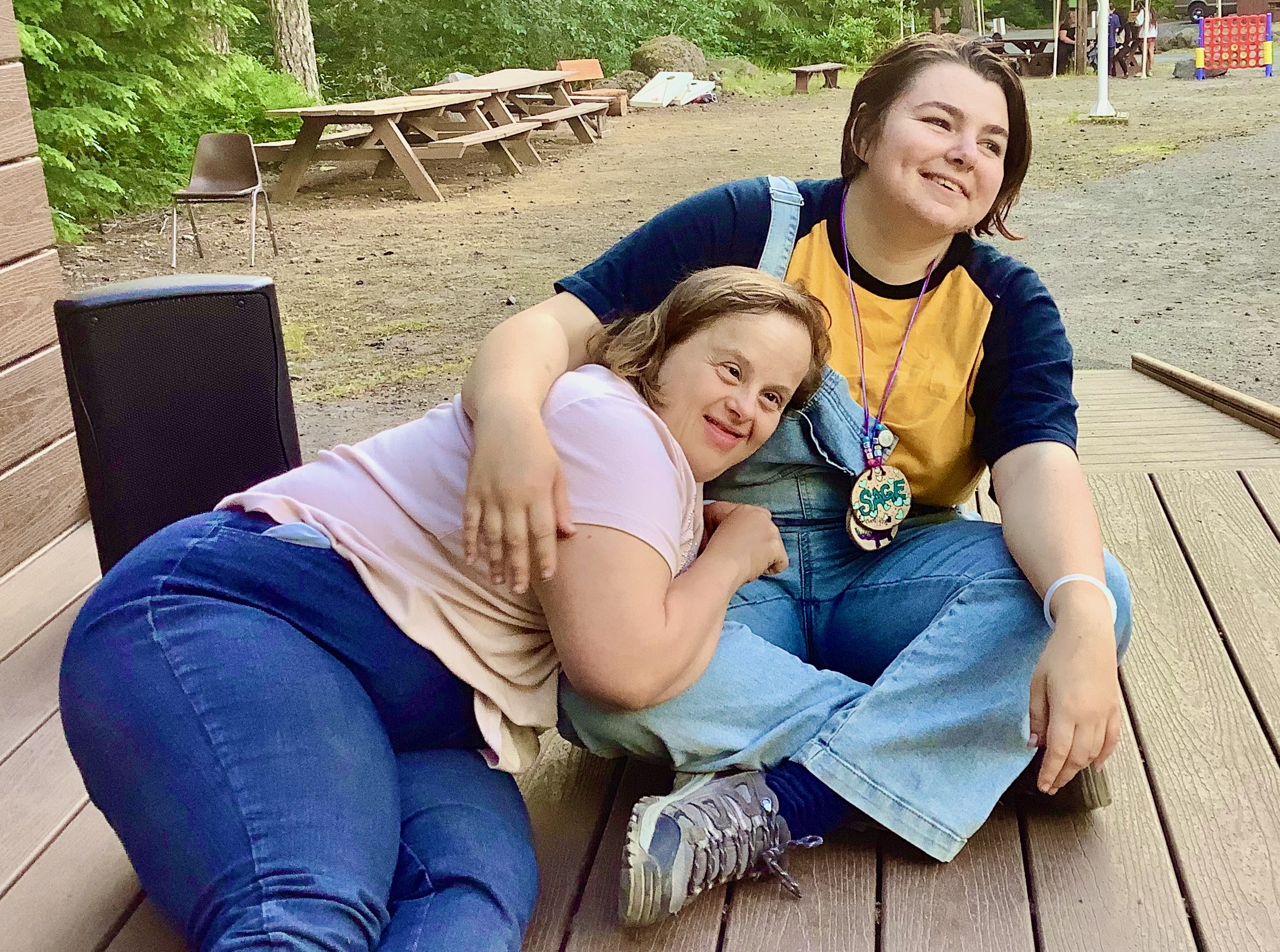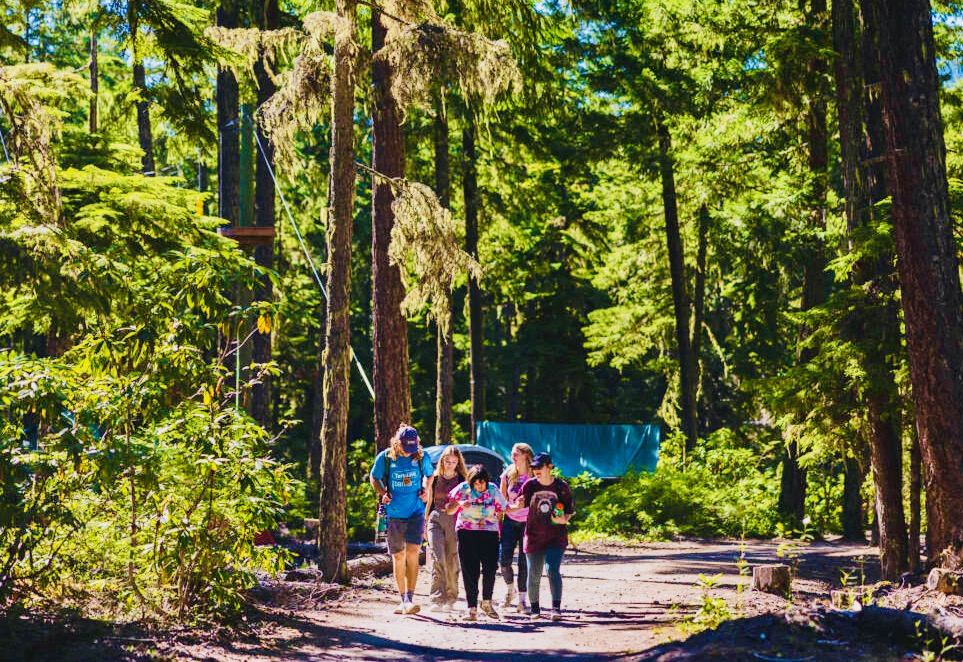About Our Campers
Information About Our Campers
Barges
Out of my window, looking in the night
I can see the barges flickering light
Silently flows the river to the sea
And the barges too go silently
Barges, I would like to go with you
I would like to sail the ocean blue
Barges, have you treasures in your hold
Do you fight with pirates brave and bold?
Out of my window looking in the night
I can see the barges flickering light
Starboard shines green and port is glowing red
I can see them flickering far ahead
-Mt. Hood Kiwanis Camp Song
Guidelines for Communication, Teaching, Grouping and Pace

by Dr. Ann Fullerton, Professor of Special Education, Portland State University
COMMUNICATION: Verbal and non-verbal interactions between counselors/staff and campers with disabilities.
- Familiarize yourself with the ways the camper communicates (i.e., communication board, sign language, non-verbal signals).
- Watch for nonverbal signs of understanding and communication including: facial expressions, gestures, body movements, and vocalizations.
- Observe campers and gauge how well they understand you and your instructions. Provide opportunities for choice and independence. Do not assume that a camper is unable to identify her/his wants, needs and/or preferences. If needed, enlist the help of someone who knows the camper.
- Model communication behavior that you want group members to use (i.e., taking turns talking, raising hands before talking, speaking quietly).
- You may need to direct questions to one camper at a time. Say the camper’s name and establish eye contact before speaking.
- Use short sentences and concrete descriptions.
- Simplify without patronizing. Don’t sing-song or baby-talk.
- If someone is an adult, talk to them as an adult.
- Be patient and flexible when you’re having a hard time understanding a camper’s speech. You may need some time before you can readily understand their speech — but soon you will.
- Never pretend to understand when you don’t. Ask camper to tell you or show you again.
- When asking a question, give campers ample time to respond; it may take longer than you are used to. Let go of the need to “fill the silence” by repeating the question or saying more. Wait for a response. Give the camper time to think and respond.
TEACHING: Leadership style and methods, instruction, and presenting program content.
- Prior to an activity, get an overview of camper’s abilities and needs, and make sure that they understand what their role will be during the activity.
- When beginning an activity, welcome and greet each group member personally. This will help to reduce anxiety, build group cohesion, and get individuals involved.
- Introduce each activity by telling and demonstrating what the camper will be doing and learning. Summarize each activity by sharing what was just completed or learned.
- Present one idea, one concept at a time and repeat key concepts!
- When applicable, use the same instructions, rules, and procedures across activities — teach in the same way.
- Encourage learning and remembering by using a variety of senses: “See it, Say it, Do it.”
- Model the behaviors you expect of campers; don’t expect campers to “do what you say but not what you do.”
- Use visual aids as much as possible when you are teaching, such as pictures, hands- on materials, maps, samples of a “finished product,” etc.
- Before giving assistance, wait and see if the camper needs or wants help. Don’t help a camper who does not need help. Don’t do it for them.
- Always promote as much independent performance as possible. Seek ways that a camper can partially participate in a meaningful way.
- Keep instructions simple. Demonstrate as you talk. Show and describe all of the steps first. Then repeat each step, having the camper complete each one before moving on.
- Give the camper the opportunity to practice several times until they have mastered or partially mastered a skill.
- Be aware of whether or not campers in your group read or write, and keep this in mind when you are using program materials.
- Choose one theme or idea and show or discuss examples of it across situations so that campers learn a few things well. For example: group themes such as teamwork, helping others, meeting challenges together; nature themes such as protecting nature, bird or plant identification, etc.
- Minimize distractions in the teaching situation as much as possible (i.e., people, noise).
GROUPING: How groups of campers are organized to participate in activities.
- Maintain a small group size or break into sub-groups when possible.
- Make sure all group members can clearly see any demonstrations and visual aids. Move campers who use wheelchairs to the front.
- Assist group members to re-focus or re-orient during transitions in between activities.
- If needed, pair up more capable campers with campers needing more assistance during an activity.
PACE: The tempo you set for a group during an activity.
- Note the “natural” pace of the group, and use it as a guide for selecting an overall pace that fits the activity and the campers. This is always a challenge — because each camper in your group will have a different “speed.”
- Be aware of camper fatigue levels. Reduce the level of physical, emotional and intellectual challenges as needed.
- Plan for and allow campers time to fully experience each activity. Do not rush campers. If needed, reduce the number of activities.
- More time may be needed when campers are handling materials, learning new skills, using communication systems, or working on cooperative tasks.
- Anticipate needing lots of time to transition between activities. Note how much time it takes and incorporate that into your planning.
- Explain changes in plans. Give campers the time they need to adjust to an activity ending and a new one beginning; or to changes (i.e., rain) in the schedule.
- Plan more time for activities requiring skill building (i.e., cooperative tasks, handling materials, making things).
- Establish and follow everyday routines in the same way each time (waking, getting dressed, etc.).
Specific Situations That May Occur
Eating Issues: Several types
- Eating too much
- Disliking certain foods
- Not eating as much as counselor would prefer
Possible Reasons
- Low metabolic rate
- Distracting environmental stimuli
- Need for attention
- Eating between meals
- Learned behavior prior to camping experience
- Personal preferences
Some ways to address concerns
- Check with camp nurse
- Give small portions and encourage each camper to try a little of everything
- Model appropriate behavior
- Make mealtime leisurely
- Check between meal eating
- Praise others in group for good eating habits
- Wait until all others are served
- Allow camper to eat in quiet area (i.e. back porch)
Homesickness: Possible Reasons
- Away from home for the first time
- No one has shown interest or concern
- Over-protection at home
- Some physical ailment
- Difficulty with structure
- Does not understand why at camp and when they will go home
Some ways to address concerns
- Get camper involved in camp activities immediately
- Rapid assignment to cabins and bunks
- Help adjust to camp routine, rules, table manners
- Keep busy with activities they enjoy
- Buddy system
- Establish communication with camper
Bed wetting: Possible Reasons
- Physical factors
- Nervousness or insufficient rest
- Afraid to get out of bed at night
- Over-consumption of liquids
- Insufficient warmth
- Deep sleeper
Some ways to address concerns
- Confer with camp nurse
- Limit fluids
- Use restrooms before retiring
- Keep restroom lighted
- Take a walk 3 hours before retiring
- Don’t ridicule — handle problem privately
The “Show-Off”: Possible Reasons
- Need attention
- Cover up for another problem
- Need to feel wanted
- Is not challenged by activities
Some ways to address concerns
- Do not give attention for show-off behavior
- Show interest in and friendship for camper
- Help camper find satisfaction in responsibility
- Recognize appropriate/constructive Camp behavior
Stealing: Possible Reasons
- Underdeveloped sense of ownership and property rights
- Striving for recognition through possessions
- Does not have the cognitive ability to recognize “theirs” vs. “mine,” on their own
Some ways to address concerns
- Seek to develop sense of ownership by:
- a) Providing private area for possessions
- b) Discouraging borrowing
- c) Encouraging collections
- Personal interview; seek camper’s viewpoint
- Use other methods to help camper gain recognition
- a) Limit situations where stealing may occur
The “Loner”: Possible Reasons
- An undeveloped sense of belonging
- Negative feelings about self and/or distrust of others
- Uncomfortable in a camp-social setting
- Away from home for the first time
- Fear of new experiences and new relationships
- Has not learned social interaction skills
- May need to reduce level of sensory and social stimulation
Some ways to address concerns
- Always know where camper is
- Show acceptance and friendship
- Plan and give camper a role in group activities
- Introduce camper to another camper she/he/they can identify with and institute a buddy system
- Explain reasons for concern
- a) Getting lost or injured
- b) Taking time and energy from staff in order to find him
- c) Describe purpose of camp
- Praise for getting involved
- Allow breaks from activities

